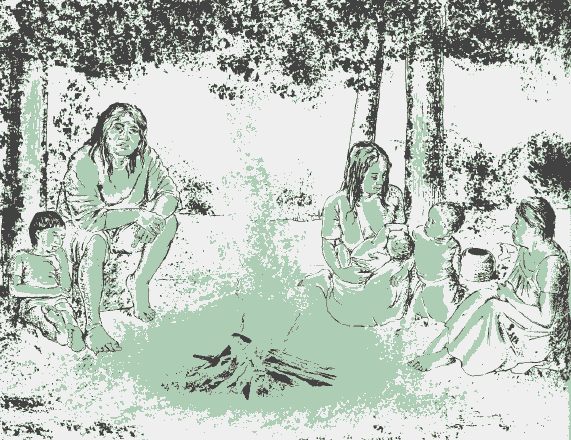



social fires, like this one in the Amazonian rain-forest, are an important part of life in most rural communities
A full granary is no guarantee against famine. Without fuel to cook with, as the women of the Sahel know well, there may be nothing to eat.
Fueling and tending the household fire has always been women's work. So has the much harder job of collecting and transporting the fuel. One study has shown that in Nepal women and girls together collect 84 percent of the fuel. Since in many countries fuelwood comprises 80 or 90 percent of all the wood consumed, this implies that women locate and fetch well over half of all the wood extracted from trees and forests.
Collecting and transporting fuelwood has always been arduous. Fuelwood shortages, though worse today than ever before, are not new: in 1795, a European explorer in what is now the Niger noticed that all wood had been stripped within three kilometres of the city of Kaarta. Today women have to walk much further than three kilometres to collect their fuelwood, and fuelwood for large towns and cities often now comes from 100 km away. The fuelwood shortage in Bangladesh, for example, is so severe that rural women and children spend an average of 3-5 hours a day gathering and transporting fuel.
Women have acquired an intimate, practical knowledge of the suitability of different tree species for cooking. Women know which trees burn slowly and which fast, which smoke and which kindle easily.
The extent of this knowledge is often surprising. In Burkina Faso, for example, women who joined a discussion about what tree species to plant in a forestry project spoke authoritatively about a certain variety of Eucalyptus. They knew that burning its leaves kept away mosquitos and that boiling them produced a broth useful for treating colds. They admitted that because the Eucalyptus thrives even under and conditions, and is not preferred by animals for fodder, it might seem useful for fuelwood plantations. But they pointed out that no part of the tree could be eaten by people or domestic stock. They said they found its wood difficult and time consuming to cut. Though light, it was also sticky. They disliked its fierce burning qualities caused by the presence of an oil in the tree which made its wood burn hot and fast- making it unsuitable for the long slow cooking needed for most local dishes. And they complained that its smoke gave food a menthol flavour and damaged the eyes. When the tree was planted in gardens or fields, they claimed it damaged other plants and poisoned the soil.
One of the common misconceptions is that women collect fuelwood simply for cooking. In fact, the homestead fire provides many other benefits. Drinking water is boiled and washing water is warmed on the fire, while fish and meat are smoked above it. The fire provides light at night, and heat to dry a wet harvest. It may also be used to cure tobacco, boil water to extract natural medicines from leaves and bark, and make dyes. The smoke from fires is used to keep insects away. In some countries, household fires are used to keep livestock warm on chilly nights (a use which, in some Thai hill villages, consumes more fuelwood than cooking- see box). Fires also have many social and ritual uses, particularly as the focal centre for evening conversations. In India, the practice of cremation, for example, consumes large amounts of fuelwood.
Thus the fuelwood women collect and transport has many functions. When it becomes short, much more than the family meal is threatened: the basis of village life is altered.

some uses of fuelwood:
1. cooking 2. water heating 3. preserving food 4. light and heat 5. drying produce 6. social and ritual uses